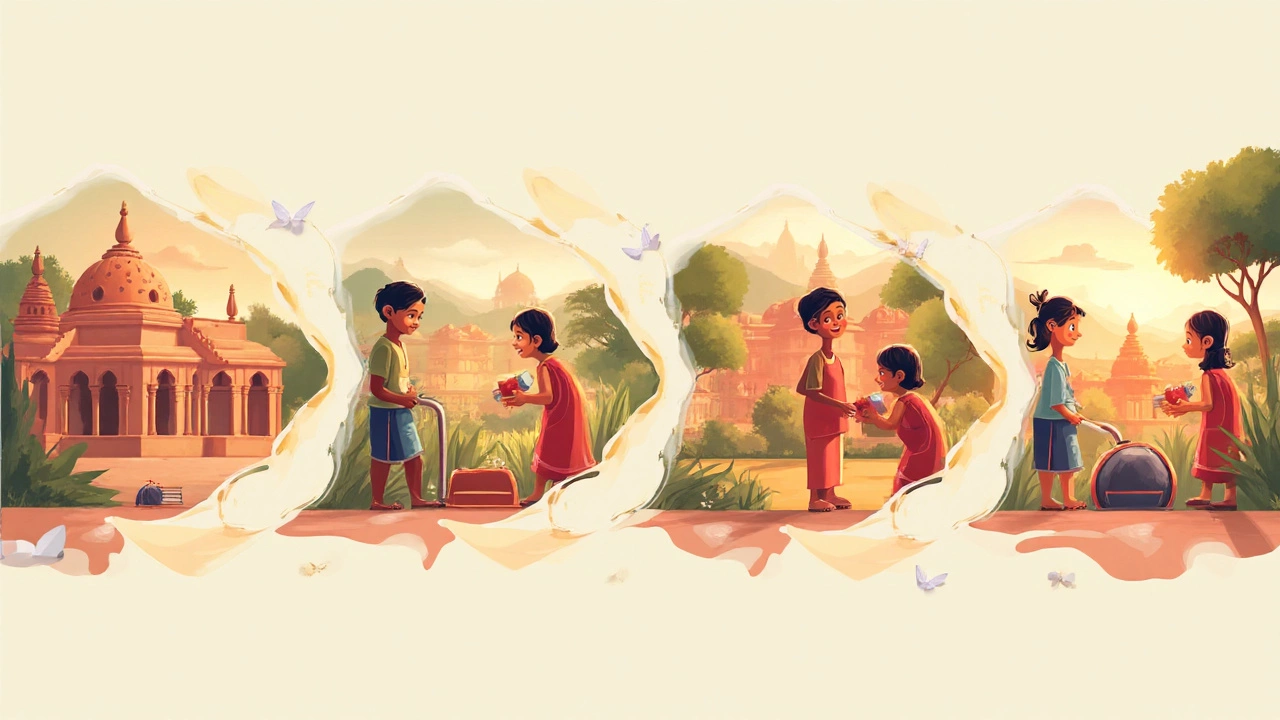What really happens when you hand over a dollar to a familiar cause or click “donate” on a nonprofit’s website? Most people think of charities as one big, blended world of goodwill. The truth? They come in all shapes and flavors—far more than most folks realize. Want to make a difference, but not sure where to focus your kindness (or cash)? Let’s break down the five main types of charities—how they work, how they spend money, and how they shape society in ways you’d probably never guess.
Charities for Relief and Social Welfare
Charities don’t just patch up wounds—they dive straight into the heart of problems like poverty, homelessness, hunger, or crisis situations. Relief and social welfare charities work on the frontlines. Think of them as the first responders of the non-profit universe. While government resources can move slow, these groups jump straight into action when things go south—a house fire, a natural disaster, or millions of hungry kids across the globe. Did you know that the World Food Programme, a humanitarian organization, fed about 128 million people in 2023 alone? Huge, right?
In this group are local soup kitchens, national organizations like the Salvation Army, and international giants like Oxfam. Some focus on quick emergency help—like blankets and meals after a hurricane. Others dig deeper, offering job skills or legal help, aiming for long-term change. Most of these charities run thanks to a nonstop army of volunteers. In the US, about 63 million people volunteer annually. That’s enough to fill every NFL, NBA, MLB, and NHL stadium—twice!
Money usually comes through donations, but grants and fundraising events play a part too. The interesting part? Many of these groups operate thrift stores and small businesses to raise extra cash. If you’ve ever dropped off a bag of clothes at Goodwill, that’s exactly how, indirectly, you’ve helped fund job training programs for people facing tough breaks. These charities are the glue that keeps communities from unraveling during hard times. They keep food on tables, roofs over heads, and hope alive when it feels impossible—and they waste no time doing it.
| Organization | Focus Area | People Helped (2023) |
|---|---|---|
| World Food Programme | Emergency Food Aid | 128 million |
| Salvation Army | Homelessness & Disaster Relief | 31 million (US) |
| Feeding America | Hunger Relief | 49 million (US) |
So, what’s the catch? The needs almost never end. These groups rely on empathy, small recurring gifts, and social sharing just as much as big checks. If you’re looking to make a real, quick impact, this charity type offers the most “bang for your buck.” But always double-check—only about 65% of relief groups spend over 75% of donations directly on programs, according to Charity Navigator. Transparency counts.
Charities Advancing Education
When charities go head-to-head with ignorance? That changes the game for future generations. Education charities create opportunities where school budgets fall short or access is lopsided. Maybe you remember book fairs, after-school clubs, or scholarships. Behind those are nonprofits working late-night hours to give kids and adults a fighting chance at knowledge.
This isn’t just about building schools or handing out textbooks. Take DonorsChoose, an online nonprofit where any teacher can ask for classroom supplies. In 2023, over 4.5 million students got books, STEM kits, and art supplies they wouldn’t have seen otherwise. Imagine a class in rural Idaho practicing computer coding because someone across the country covered the cost of a $30 kit. That’s impact you can measure, and it’s happening daily.
Many education charities also run workshops, online courses, or mentorship programs. Some, like Boys & Girls Clubs of America, focus on tutoring, life skills, and leadership—keeping doors open after the last bell rings. Others, like Khan Academy, provide free online education to anyone with an internet connection. Talk about scale—the Khan Academy had over 135 million users last year, all learning subjects from algebra to art history, zero cost attached.
How do they keep the lights on? Most rely heavily on online donations and corporate partnerships—a tech company might donate tablets, or a shoe brand funds a summer camp. Scholarship charities usually build endowments, investing big gifts so students can benefit year after year.
| Charity | Focus Area | Impact (2024) |
|---|---|---|
| DonorsChoose | School Classroom Resources | 4.5 million students supported |
| Khan Academy | Free Global Online Education | 135 million users |
| Scholarship America | College Scholarships | 127,000 scholarships given |
Looking for the smartest way to give? Think local—neighborhood libraries or afterschool clubs often stretch donations further than national giants. Pro tip: Ask the director what $50 does for them. You’ll learn fast whether funds buy a single workbook or a dozen backpacks for children in need.

Charities for Health and Medical Research
We feel the impact of health-related charities every time we see a pink ribbon or lace up shoes for a local walkathon. These organizations power some of the greatest leaps in medical care, disease prevention, and public health. Many folks don’t realize that a chunk of lifesaving research isn’t government-funded—it comes from these nonprofits. The American Cancer Society alone funneled over $160 million into research grants last year, chasing better treatments for 1.9 million new cancer cases in 2023 in the U.S.
But it’s not all giant labs and million-dollar grants. Countless smaller groups work hand-in-hand with hospitals, offering support to families whose children have rare diseases. Others fund hospital playrooms, rehab animals, or deliver meals to chemo patients who are too tired to cook. Sometimes that comfort and connection is just as vital as new medicine.
Health charities break into two main slices: those directly helping people (like Make-A-Wish Foundation granting 17,000 wishes in the U.S. last year) and those focused on finding cures, like the Alzheimer’s Association, funding over 600 research projects worldwide as of mid-2025. Many nonprofits combine both—offering helplines, patient navigation, and grief counseling to families navigating crisis or loss. Practical help is huge. According to a recent Pew study, 72% of Americans say health charities helped them or someone they love—whether with medical bills, prescription cost help, or rides to treatment they couldn’t afford otherwise.
Where do funds come from? Think charity runs, bake sales, and, yes, tons of text-to-give campaigns. November’s “Movember” movement saw more than 5 million moustaches (and $100 million) grown worldwide last year to support men’s health research. The big tip: Check exactly where your dollars go. Reputable groups usually keep administration costs below 25% and publish detailed reports online. The more transparent, the better.
| Organization | Key Statistic (2023-2025) | Focus |
|---|---|---|
| American Cancer Society | $160M Research Funding | Cancer Research & Support |
| Alzheimer’s Association | 600+ Projects Funded | Brain Health & Support |
| Make-A-Wish Foundation | 17,000 Wishes Granted (US) | Support for Ill Children |
If you want your charity dollar to reach patients—rather than being swallowed up by red tape—stick to groups with a strong local presence or those reporting high levels of program spending. And remember, every dollar can help fund new treatments, fuel vital support, or unlock precious time with loved ones fighting their hardest battles.
Charities for Environmental and Animal Causes
The planet needs more than reusable tote bags to survive—and that’s where environment and animal charities step in. These nonprofits protect endangered species, restore forests, clean up oceans, and fight climate issues with both gritty hands-on efforts and relentless advocacy work. Back in 2024, The Nature Conservancy announced they’d protected an extra 2 million acres of wild land, pushing their global total to over 153 million acres. That’s bigger than the entire state of California, set aside forever for wildlife, trees, and clean water.
Some charities work on the ground—replanting trees after wildfires or rescuing sea turtles tangled in netting. Others focus purely on policy: pushing lawmakers to protect habitats or switch to renewables. The World Wide Fund for Nature (WWF) combines both, working in over 100 countries to fight deforestation, illegal wildlife trade, and ocean pollution. In 2023, WWF’s public campaigns helped drive eight countries to ban single-use plastics in protected areas. It’s a fight you can actually track and quantify as the world changes.
Animal-centered charities run the gamut, from huge names like the ASPCA (which found forever homes for 4.3 million pets in 2024) to local shelters hustling every day for food and vaccine donations. Unique projects crop up all the time—a “senior dog retirement home” in Oregon, elephant sanctuaries in Africa, or coral reef recovery crews in Australia. One fun fact: the Donkey Sanctuary in the UK cares for over 7,000 rescued donkeys, giving even the world’s most humble animals a second shot at peace.
| Organization | Major Achievement (2023-2025) | Focus |
|---|---|---|
| The Nature Conservancy | 153M acres protected | Land & Water Conservation |
| WWF | 8 countries banned plastics in reserves | Wildlife & Habitat |
| ASPCA | 4.3M adoptions in 2024 | Animal Protection |
Most green and animal charities fundraise with membership drives, colorful wildlife adoptions (who hasn’t been gifted a “symbolic panda”?), or crowd-powered petitions that reach lawmakers. Want to spot the best ones? Look at nuts-and-bolts progress—acres saved, animals treated, plastic removed from beaches. Don’t be fooled by pretty pictures alone; the best groups post annual data and invite public audits. Support them if you want your kindness to ripple out for generations.

Charities for Arts, Culture, and Community
Museum doors swing open, kids take first dance steps, murals appear overnight on bridge underpasses—all thanks to charities that breathe life into arts and culture. Sure, these don’t always get the headlines, but they’re at the heart of vibrant, healthy communities, nurturing everything from jazz bands to skate parks in neighborhoods where tickets and classes cost too much.
Arts charities don’t just fund performance halls or glitzy galleries. They work behind the scenes: giving scholarships to young musicians, buying instruments for school bands, or running painting workshops for seniors. After Covid-19, giving in this space jumped 14% worldwide, as folks realized how much they missed music, museums, and festivals. The National Endowment for the Arts reported in 2024 that donations covered more than 30,000 free events across the US alone. Elsewhere, groups like GlobalGiving fund reading corners and mobile libraries for communities with no books. Even small dollars add up—donate $20 to a theater group, and that might buy enough paint for a whole set or costumes for a kids’ play.
Community-building charities pour effort into local festivals, street fairs, language classes, and public art. They help immigrants find mentors, neighbors organize gardens, and veterans transition back into community life. The Girl Scouts—yes, the cookie legends—run thousands of science, tech, engineering, and math (STEM) programs just for girls, boosting diversity in careers that shape our digital future. The effect stretches way past cookies. Over 1.7 million girls and adults participate every year, building skills with every troop meeting and outdoor hike.
| Organization | Recent Impact (2024-2025) | Focus Area |
|---|---|---|
| National Endowment for the Arts | 30,000 free US events funded | Arts & Culture |
| Girl Scouts of the USA | 1.7 million members | Youth Development |
| GlobalGiving | 1,400 projects funded | Community Projects |
If you want to see change close to home—and enjoy how your donation shapes the world you actually see—arts and community charities are a smart bet. Ask if they host open events; many encourage donors to attend, so you get to share the joy you’ve sparked. The best part? Sometimes, a few dollars can light up a whole block or spark a lifelong love of art for a kid who would never have gotten the chance otherwise.
